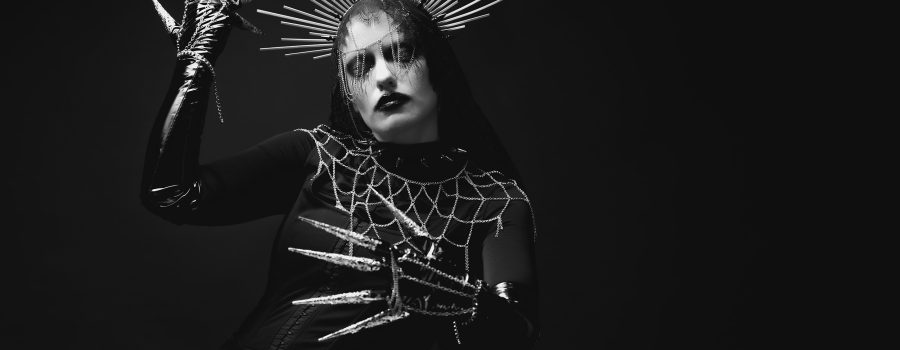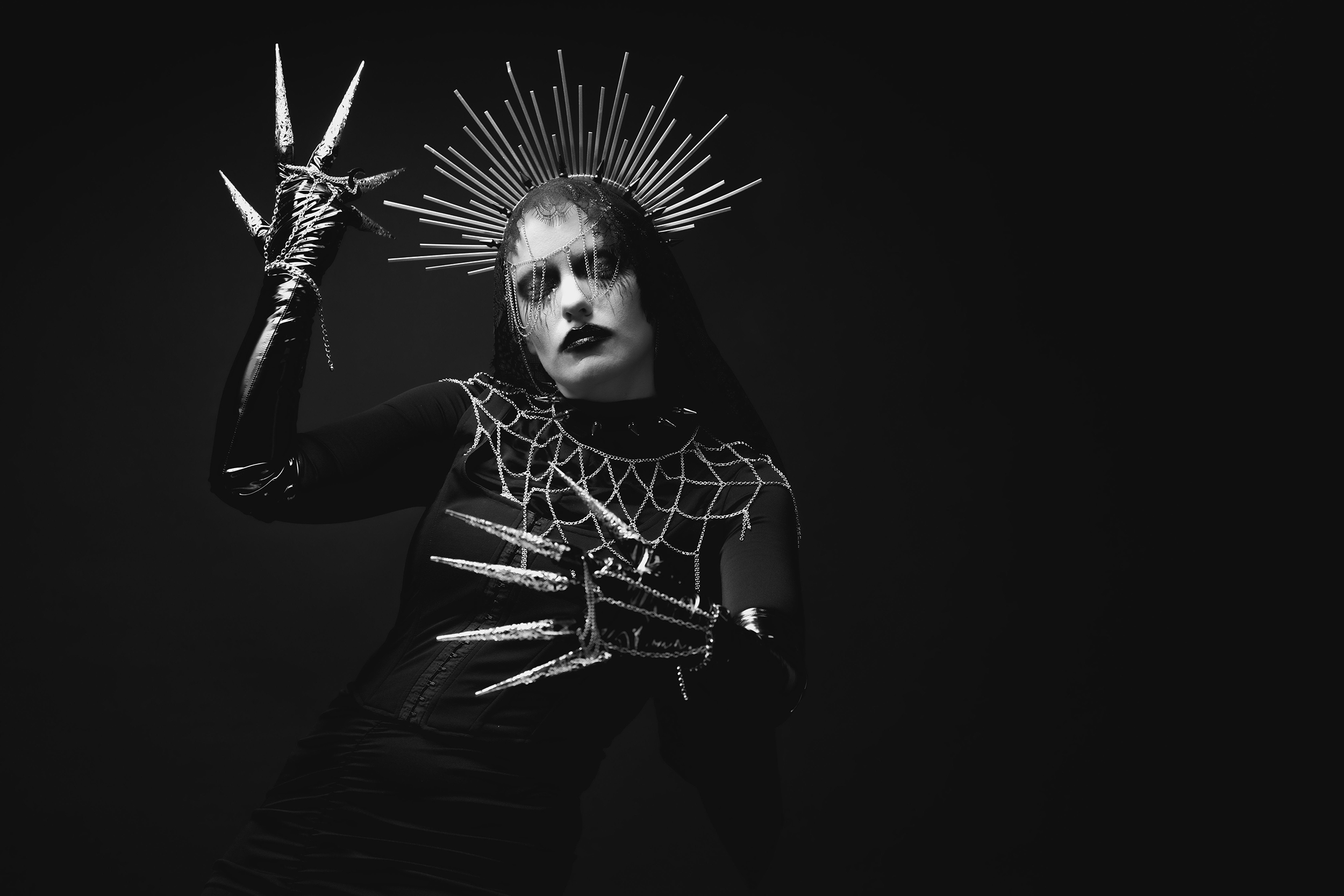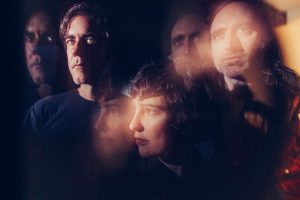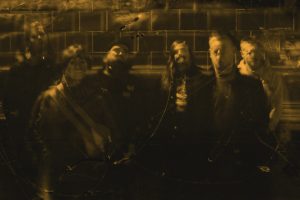There is nothing quite as exciting as discovering new artists that pave the way for sonic and thematic exploration that goes beyond the ordinary. One such artist is Lana Del Rabies, the dark electronic and genre-bridging alter-ego of Phoenix-based musician, producer and multimedia artist Sam An. With origins as an experimental project that re-contextualized the more ominous aspects of modern pop music made by women – like that of her namesake, Lana Del Rey -, Lana Del Rabies’ music incorporates industrial, gothic noise and metal, with experimental, darkwave and ambient elements. Her work thematically embodies discordant spaces between the occult and the political, personal trauma and collective grief, as well as brutality and benediction.
In a few days, Lana Del Rabies is set to release her third offering unto the world, STREGA BEATA, a fantastic work that delves deep into an apocalyptic myth told through dense and textural compositions pulling from the vast corners of the darker genres of music. With this release in mind, we spoke with Sam An about her relationship with music growing up, the influences that inspired the foundation of Lana Del Rabies and what the creative and recording process was like for STREGA BEATA.
Tell us a bit about your relationship with music growing up: what was your first contact with music and how did you start playing?
I have always loved many genres of music throughout my life. As a young kid, I liked pop and R&B, but I also secretly liked metal and rock music. Once I hit my early teens, I became kind of obsessed with learning about the history of contemporary music and music subcultures. In terms of playing, I studied a little bit of music in school, but I was never traditionally or classically trained in any instrument. I was always drawn to singing and performing, and I did things like dance and gymnastics, but I was too shy and anxious about singing publicly. It took me until my early 20’s to get comfortable singing in front of other people. I went through a kind of a punk phase in my early teens, so I really wanted to learn guitar, but I didn’t have access to really learning more about it in my youth. I know a little bit about playing now, but it’s very basic. What finally got me into actually making music was getting my own laptop and learning how to edit audio. I started out doing a lot with GarageBand, then I learned Ableton, and it went from there.
“I was always drawn to singing and performing, and I did things like dance and gymnastics, but I was too shy and anxious about singing publicly. It took me until my early 20’s to get comfortable singing in front of other people.”
Did you have any lessons when you first started playing music?
When I was a kid through school, otherwise no. Anything I’ve learned in terms of electronic music was taught to me by friends, through video tutorials, or I figured it out on my own. With other instruments, I will look up things or ask people questions if there’s something I want to know, but otherwise I’ve always played things by ear – piano, guitar, bass, synths, beats, and samples. It’s all kind of been more about the sound and less about the structure.
Were you in any bands before starting your own solo project?
I was a part of an experimental drone duo when I first started playing publicly called Teen Summit. Other than that, nothing worth noting.
The name Lana Del Rabies bears a striking resemblance to Lana Del Rey. Have you gotten any sort of criticism for using such a similar name?
It’s an intentional play on her name; my early work was noisy drone sound collages that I made by sampling contemporary women in pop music. Lana was someone I ended up going back to a lot, and in hindsight, I think it was because there was something vulnerable and codependent in her early work that I related to, but also was at odds with myself about. I remember I wanted to settle on a name for a solo project, and I went with Lana Del Rabies for that reason, and I am also good at coming up with plays on words like that.
The biggest issue I’ve run into is people misunderstanding the project, like they think it’s supposed to be funny or quirky, or they just don’t take me seriously. I ran into that a lot more around 4-5 years ago, and it was part of the reason I tried to change the name when I did. People seem to be less hung up on it now. I have gotten mild backlash from some Lana Del Rey fans online, but that’s not really that bad – and I don’t have anything against Lana Del Rey.
What were some of your influences when starting out?
I think I’ve had a lot of influences musically throughout my life, but when I think about what I was inspired by at the formation of the Lana Del Rabies project, the most obvious acts that come to mind are The Body, Pharmakon, Crystal Castles (specifically Alice Glass), Chelsea Wolfe, Einstürzende Neubauten, HEALTH, Xiu Xiu, Have a Nice Life, The Soft Moon, The Sisters of Mercy, Skinny Puppy, Portishead, Bauhaus, Neurosis, Prurient, Gazelle Twin, and my forever favorite, Nine Inch Nails.
Going into your upcoming record, how was the creative and recording process like for STREGA BEATA?
Kind of grueling, to be honest. I will say almost nothing about this record was a fun process, which I’d like to change for future releases. Essentially, the initial writing came during a very complicated time for me personally. My last record, Shadow World, was written during a period of self-destructive behaviors and a turbulent time politically. Though the world is still in an uncertain place, I am at least much more mentally healthy now. But in 2018, I was starting a new phase of my life where I had to cope with things differently and deal with a lot of shame.
I initially wanted STREGA BEATA to be its own project because I wanted a fresh start without the baggage of being “Lana Del Rabies”. I had started writing the record with a story in mind, which I’d never done before. I consider myself a spiritual person who likes to learn about mythology, the occult, and the ways in which different cultural stories from around the world intersect with the same themes and archetypes we are drawn to as humans. I basically created this story from the perspective of a deity watching her creation (humanity) destroy itself, and the pain that comes from that. I also wanted to push myself to compose music in a more dense and complicated way, which is why a lot of the tracks on this record are longer and have actual instruments.
What were some themes and ideas that you wanted to explore this time around?
I initially wanted to explore the idea of pain, rage and revenge through a mythical story, but it actually ended up being more about grief. This record took about three years longer than I originally intended because I ended up touring in 2019 and then I had two years of being isolated by the pandemic, with my project in limbo. During that time, a lot was lost and I personally saw how death affects everything close to you. It changed how I approached the record, and the perspective of the deity character turned into one of grief over the destruction of her world, and also having to potentially help annihilate it so that everything can renew. In a lot of ways, I also had to destroy a lot about the person I used to be so that I could start over. I even destroyed the Lana Del Rabies project for a few years in the process.
“Master” and “Mourning” were originally a part of another solo project of yours entitled Beata. What prompted you to revisit these tracks?
For me, these tracks were always a part of one album and project, it was just the name that changed. I originally could not see myself releasing any of the tracks that are on STREGA BEATA under Lana Del Rabies because I felt like the project name had too much baggage. I ended up announcing the project shift earlier than intended because of the pandemic, and I wasn’t sure what was going to happen. I did not imagine that I would be almost inactive for two years. I was releasing demos of the stuff I was writing because I honestly didn’t know what else to do. So, the tracks weren’t really revisited, I just didn’t give up on them.
At the time of the announcement of this new record, you mentioned that STREGA BEATA was almost entirely shelved. What did you mean by that and what happened that made you go back and decide to release it?
The pandemic had changed all of my plans for shifting into a new project and I honestly felt really lost about where I was as an artist for awhile. I’d abandoned Lana Del Rabies, then the project name was Beata, then Strega Beata. Things with the pandemic after a couple years got so uncertain, I reached a point where I basically almost quit music entirely, even though I had a full record done that I had worked on for 3 years. I was so disconnected from the music world and community that I assumed everything with my career was done and putting it out was going to be futile. It took me getting back out into the world in 2022 to realize that the Lana project actually meant something to some people and that most of the baggage wasn’t worth quitting over. I decided to release the record under Lana Del Rabies with the name, STREGA BEATA, because I couldn’t imagine it being anything else.
The artwork of STREGA BEATA was done by Maria Mendes. When choosing a cover for this record, did you select it from existing works that Mendes had or did you commission the piece?
My fiancé, the electronic music artist Terminal 11, had worked with Maria on a project, which is how I found out about her work. I loved the otherworldly quality of her work, and how the figures in her images were destroyed but beautiful, or looked like they were still being formed. It was also important to me that this album did not have me on the cover image. I commissioned her to interpret an idea I had for a religious looking goddess figure being destroyed by light. I wanted the figure to exist in a space not bound by the earth, and to embody something uncomfortable but beautiful about the process of death and birth. She did an amazing job.
Do you always seek to create a connection between the cover of a record and the music within it?
Yes, though this was the first record I’ve done where I had an idea of what the imagery was going to be before the record was done. For my other releases, I like to finish what I’m working on and then create an image that represents something about the feeling of the tracks. My other release covers were all created by me, so having another artist create the cover of STREGA BEATA is unusual for me.
As with previous releases, STREGA BEATA was produced and mixed entirely by yourself. Is there a particular reason why you choose to take a more DIY approach when it comes to your music instead of using external assistance?
Honestly, when I started writing, I didn’t even realize that it was normal for other artists to seek out people to mix their records. I worked with someone to help mix Shadow World because I thought it would add something I was maybe missing, and I realized I was basically agreeing with them on what I would have already done myself. The production part of it is also so much of Lana Del Rabies, so for me, to collaborate or give that to someone else is a different project entirely. I like collaboration, but to not have as much of a hand in it would mean it’s something else.
After the release of STREGA BEATA, what does the future look like for Lana Del Rabies? Any upcoming shows or tours you would like to mention?
I have a record release show in Austin, Texas, on March 18th, alongside a lot of amazing artists, who are mostly affiliated with Somatic Records. The show is also during SXSW. Other than that, nothing I can talk about yet. My hope is to do more shows in the US and abroad.
“It took me getting back out into the world in 2022 to realize that the Lana project actually meant something to some people and that most of the baggage wasn’t worth quitting over. I decided to release the record under Lana Del Rabies with the name, STREGA BEATA, because I couldn’t imagine it being anything else.”
Interview by Filipe Silva
Photo by Josue Orozco, courtesy of Lana Del Rabies








Leave a Reply
Your email is safe with us.